News Blas: October
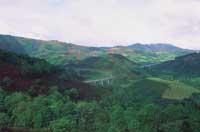
As in the previous month, in October you can find numerous fruits in our mountains. The chestnut trees have curved branches filled with blackberries and some oaks and beech acorns. In the southern vineyards the time has come to harvest. An intense day on land where excellent wines from Navarre and Alava are produced. When collecting the clusters, many specimens fall to the ground, but do not think they are wasted. And it is that there are many animal species that will come to eat this delicious food, because after all what must be done in this time is to eat as much as possible and try to accumulate reserves, winter... that is knocking us the door.
Flying spiders
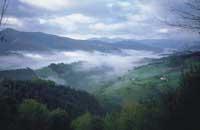
Many of the animals born this year have the time to spread them out of the place of origin. Rather than staying in the family environment, these young people have better to open up to the surroundings to find food and become owners of a territory. Arboreal people born in the fridge by the river, for example, are on the shore and, even if it seems a lie, will fly. Of course, spiders have no wings, but they go up to a branch, and once released from the abdomen a thin, long grain of silk, they just have to wait for some autumn flute. With the whipping of the wind... Air! spiders will fly to new territories.
Beekeepers collecting honey
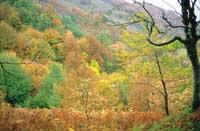
Terrible bee swirl in a hive. The beekeeper has his head and hands full of bees, but the smoke that he bravely expels and, of course, the special suit makes him calm. Less bad than the punctures of the bees are no joke. This year's one has gone in favor and looks abundant honey in the cattle. However, our wise beekeeper knows perfectly well that honey is the essential food of bees during the winter and therefore, taking half for home, has left the rest for them.
Lindux looking up
In these days when our mountains are dressed in red, we can stay very strong looking at migratory birds. Both day and night, in times of passage, thousands of birds of different species go south. Although the heights of Lindux or Zegama are very famous, in the mountains of Euskal Herria we have hundreds of necklaces to observe migration.
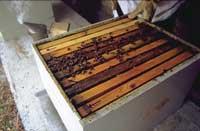
Migration is a successful and widespread strategy among animals. In these long journeys, weakened, trapped by enemies, lost, and although many other species of birds die, many others advance and grow in the following spring balance the populations. However, man-made habitat loss and abusive bird hunting (of a few species nearby and many of them, in addition to full rights, in the poorest regions of Africa) could endanger the future of some species.
Month of pigeons
We have already mentioned that October is a month of bird migration. But this is why in Euskal Herria there are about 100,000 shotguns looking up for pigeons, foxes and other passing birds. Undoubtedly, the most appreciated species is the torcaz dove. The days of passage of this elegant bird are usually spectacular and it seems that in recent years there are more hunters on our necks than ever, and despite the best shotguns and cartridges, no more pigeon is caught. In fact, the pigeons that enter the Peninsula, with the passing of the shots, learn not to reach the ground and go to the territories of the southwest of Spain in a vertiginous way.
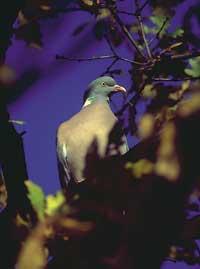
We cannot fail to mention the surprising system they use in Etxalar or Sara. In these villages they continue with the nets they have used for centuries in the hunting of the dove. As the bands or balances are approaching, wooden pallets are thrown that make of hawk so that the pigeons fall and frighten the nets. Thus, between 1,000 and 3,000 pigeons per year are captured in the Etxalar pigeons.
Others prepare to sleep
The marmots from the heights of Belagua look like fat balls. The tenor that begins to hibernate is nearby and starts to poach. The first rays of sun are launched as soon as they appear and, although they are normally espadrilles animals, at this time they do not usually have laziness time. They feed on the grass and dedicate themselves to picking the grass to prepare the winter t-shirt.
The bear is also in this factory. In the last few weeks, along with the two young born this year, it is eating and eating fruits until the end of the dung. If not, next month or (depending on weather conditions) will get into the winter ferment along with the offspring.
Squirrel fills warehouses

Throughout its intense march, the squirrel is collecting its fruits. Despite being a little fatter than normal, he has descended from head to head from an oak looking for acorns. Not being able to eat all the fruits that there is, without wasting time, the squirrel is organizing special warehouses for the winter. It already has the hole of an old half-full oak and today has started to build the nest in a beech. In addition, in the soil it keeps many fruits and although he does not know, thanks to it helps to restore the forest. In fact, the squirrel forgets many of these underground deposits and if some other animal does not find them, the seeds will bring new plants.
Around with the wolves
West of Alava and Bizkaia, wolves have caused a year more significant losses in some herds. In hunts organized by hunters and ranchers they have managed to kill a lot, but they have freed one or the other: those who have had the most luck or... the fastest wolves, who knows!

Playing with the heart, although it is difficult to admit the hunt for such a scarce animal in Euskal Herria, with the head you can see things differently. With the grazing system that we have today in our territory (the shepherds are not entirely with the livestock and grazing is hardly used) it is normal that many problems arise between wolves and shepherds. However, taking into account the excellent motive capacity of wolves, these animals could begin to adapt to the places where wild animals abound and live without just causing discomfort to livestock. In this time when winter approaches, we want to wish the wolves a little luck to settle in new, quieter territories and pastors so that they can develop their work in peace. But it’s not easy… so be it!





